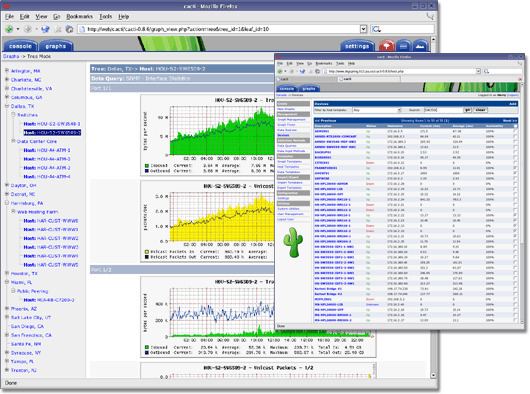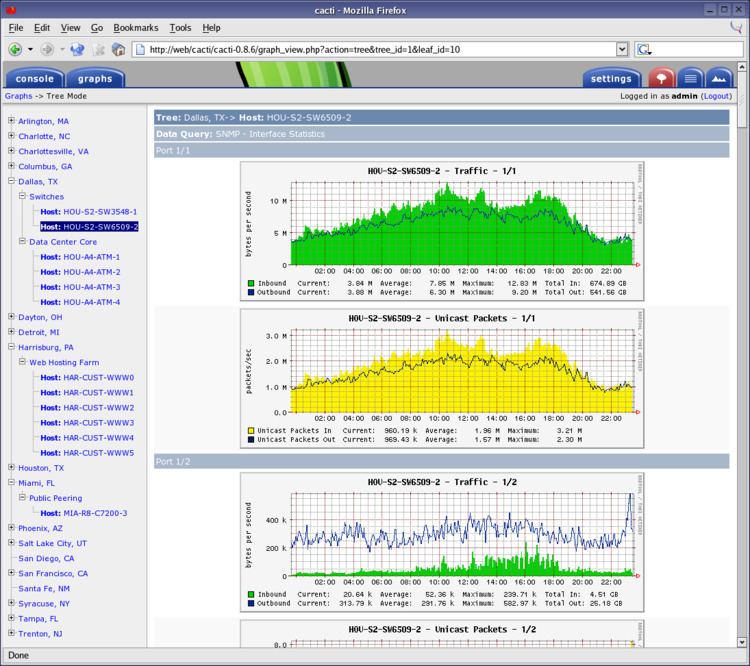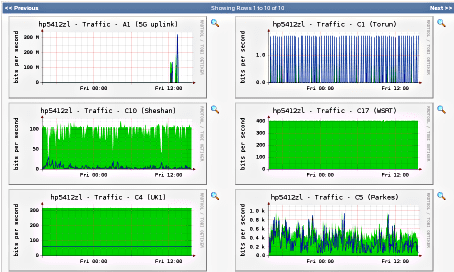Developer(s) The Cacti Group, Inc. | Repository svn.cacti.net/cacti Operating system | |
 | ||
Initial release September 23, 2001; 15 years ago (2001-09-23) Stable release 1.0.3 (February 15, 2017; 19 days ago (2017-02-15)) [±] | ||
Cacti network monitoring ubuntu installing configuring and adding devices to map
Cacti is an open-source, web-based network monitoring and graphing tool designed as a front-end application for the open-source, industry-standard data logging tool RRDtool. Cacti allows a user to poll services at predetermined intervals and graph the resulting data. It is generally used to graph time-series data of metrics such as CPU load and network bandwidth utilization. A common usage is to monitor network traffic by polling a network switch or router interface via Simple Network Management Protocol (SNMP).
Contents
- Cacti network monitoring ubuntu installing configuring and adding devices to map
- How to monitor devices with cacti
- History
- Features
- References

The front end can handle multiple users, each with their own graph sets, so it is sometimes used by web hosting providers (especially dedicated server, virtual private server, and collocation providers) to display bandwidth statistics for their customers. It can be used to configure the data collection itself, allowing certain setups to be monitored without any manual configuration of RRDtool. Cacti can be extended to monitor any source via shell scripts and executables.
Cacti can use one of two back ends: "cmd.php", a PHP script suitable for smaller installations, or "Spine" (formerly Cactid), a C-based poller which can scale to thousands of hosts.

How to monitor devices with cacti
History

The Cacti project was first started by Ian Berry on September 2, 2001. Berry was inspired to start the project while working for a small ISP while also still in high school, learning PHP and MySQL. His central aim in creating Cacti "was to offer more ease of use than RRDtool and more flexibility than MRTG."

On September 13, 2004, version 0.8.6 was released, and with it came more developers and, later on, greater program speed and scalability.
Version 0.8.7 was released for use in October 2007. In June 2012, a roadmap on the website indicated that version 1.0.0 was scheduled for release in the first quarter of 2013, but by August 2013 it was replaced by a notice that "This roadmap is out of date. We are reorganizing to improve the development cycle of Cacti. More information coming before the end of 2013!".

Version 0.8.8c was released in August 2014 with numerous bug and security issues patched, and a few new features.
Version 0.8.8d was released in June 2015 with numerous bugs patched.
Version 0.8.8e was released in July 2015 with numerous bug and security issues patched.
Version 0.8.8f was released in July 2015 with some bugs patched.
Version 0.8.8g was released in February 2016 with numerous bugs patched.
Version 0.8.8h was released in May 2016 with some bugs patched.
Version 1.0.0 was released in January 2017
Features
The primary features of Cacti include:

